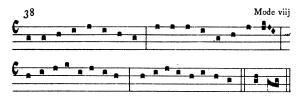Here’s an amazing piece of poetic political commentary over at Mad Priest’s place
Daily Archives: April 29, 2008
Chant and “Liber Usualis Modern Notation”
Several things are conspiring to make me think about chant this morning. I’ve been splitting the Sarum hymn tunes into discrete jpeg files—like this one:
suitable for for use at Matins with Aurora lucis utilat and Lauds with Sermone blando Angelus. Too, at breakfast my Shuffle turned up the Enigma track that samples the Kyrie from the Missa Orbis Factor. Furthermore, I was looking at my blog stats. I get a lot of hits from Office hymn titles or searches for the Liber usualis.
One of the most common, though, is “Liber Usualis modern notation”. If you came here through this search term, I’ll make a quick comment on this topic. I don’t have one here and you’re not likely to find one. Why? Well—it’s about time economies. It would take an awful lot of time to translate the notation from the Liber into modern notation and the genuine fact is that the modern notation version would be inherently inaccurate because of the differences between modern music and chant. Even modern chant notation wouldn’t really do the trick.
So, that’s one half of the time economy; it would take a lot of time to produce it and the result would be imperfect. Now—here’s the other part. Chant notation only looks intimidating; it can be learned quite easily. Once learned, you can use it to read all sorts of things that go beyond the Liber. If you want to learn, I’d recommend starting with this excellent introduction, then download the Liber usualis, and go to your cd collection. If you have some basic chant cds—like “Chant” and “Chant II” from de Silos produced a few years back—cue a track, locate the chant in the Liber, and sing along. Start with the simple, then go from there. And look here for links to more introductions, scores, and audio files.
An Act of Recalibration
Go read Christopher’s latest post. He and I have been working around some similar themes of late especially in terms of what is going on at a national level in the church.
Christian social justice is not separate from personal holiness nor vice versa. In fact, they’re really not in opposition to one another despite what various “culture warriors” want you to think. However, both of them are only Christian when they flow from the Gospel.
Christopher makes mention of the Benedictine tradition. Now, when I think and say “Benedictine”, I often conjure up in my head a kind of idealized Benedictine spirit that I believe existed in ninth century Europe as mediated through my experience with Benedictine teachers I’ve had and monasteries I’ve visited.
But there are other very real and important parts of the Benedictine tradition that I would do well to remember.
The monastic house of Cluny, founded in 909 was by the end of the 11th century to become the head of a sprawling family of houses throughout the Continent and in England as well. At its founding it was devoted to a strict interpretation of the Rule. As time went on, things changed… Because of its later years, the name of Cluny is now associated with liturgical excess. A reading of its customaries reveals that the monks were actively in choir over eight hours a day. Now—liturgy is good; but that doesn’t mean that more liturgy is better. Rather, Cluny lost the balance of the Rule that demanded physical labor and study in addition to hours in the choir. Many scholar of the period regard the use of lay brethren as a kind of second-class citizen to do the physical work as a sign of the decay that eventually led to Cluny’s collapse.
What came in its stead was the Cistercian revolution. More ascetical, less liturgical (by comparison—still far more liturgical than anything most of us have ever known) The Cistercians re-emphasized the principle of balance. They did not jettison the old. Indeed, the use of silence outside the choir was a central feature of Cluniac spirituality retained and heightened by the Cistercian reformers. Fundamentally as an act of Reformation, it was an act of Recalibration.
While I make no secret of my love of Cluny and its liturgies even when they tend to excess, the Cistercians proved themselves a necessary and important part of the Benedictine tradition. And, in their in their path of Recalibration it would suit us now to walk.
We face different challenges, of course. And yet—the balance of the liturgical life, the intellectual life, and the active life still, I believe, burns at the heart of the Anglican way. We would do well to recalibrate.
